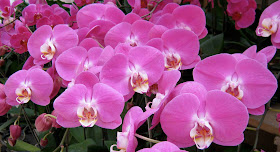The phalaenopsis is called "mariposa" or butterfly orchid in the Philippines. As a country, the Philippines is home to the most number of the species of this type of orchid. Most of the species with large flowers are white while those with pink flowers either have mostly small or medium-sized blooms. Among those with the biggest pink flowers is phalaenopsis schelliriana popularly known as "tiger orchid" in Manila due to the spotted or banded leaves. Others like phalaenopsis equestris have small flowers.
Due to the persistence of breeders, not only did the flowers become bigger, almost rivaling the large whites in size but the color has also become more intense, called "hot pink" by orchid fanciers.
Taiwan has all shades and sizes - from the biggest flowers with the darkest tone to the smallest with the most delicate shade.


Most of these pink phals started out to be inferior to the large whites in terms of size. However, the best ones are almost equal to the whites in terms of floriferousness and size. The picture on the left shows a spike of pink phalaenopsis that other than the color may be mistaken for a large white.
This impressive spike length comes from the age and health of the plant. The maturity of the plant and the quality of care it has been given will be reflected in the length of the flower spike.
The picture on the right are of spikes from young plants. By the next flowering, these could very well be as long as the one on the left.

Since these plants are clones, they look exactly alike with the only difference being in the number of flowers in a spike. Some keen observers and growers note however that with superior culture, the flower quality in terms of size and substance can still improve.
These type of orchids like filtered light and good air circulation. While they like high humidity, they simply could not stand areas with little or no air circulation and will easily succumb to all kinds of diseases.
The species are found on branches and trunks of trees where they are receiving dappled sunlight. Very few can survive full sun exposure without being burned.
Size difference is easy to perceive but substance has to be assessed mostly by touch to be appreciated. It may take someone with a little bit of knowledge to point out the difference initially but once one gets the hang of it, it becomes quite easy to see the differences.

To the left is a picture of first-time bloomers. Note the relative shortness of the flower spike with six to eight flowers and buds per spike. More mature plants like the ones on the right, will have about ten flowers per spike while those that are older will have 14 or more flowers

The pink phalaenopsis come in different shades. The clone above is pale/pastel pink and is almost like a debutante, oozing sweetness and innocence.
The one below provides contrast between the dark pink petals and sepals and the white lip and middle portion of the flower. These plants are first bloomers as evidenced by the short spike and fewer flowers.
Here again (right and below) is contrast in another form.
This variety features a pale pink base suffused with a darker pink in the center with the lip showing a distinct yellow for a three way color combination.

Yet another variant is the pink with splash-like pattern on the petals and sepals making for a most interesting bloom. Both the pictures on the right and below show this pattern contrasting only in terms of the darkness of the pink base color.
All these flowers are first-time bloomers so it would be really beautiful to see these plants flowering at a more mature stage.
Phalaenopsis has emerged as the most cultivated orchid primarily due to its ability to keep its bloom for a long period of time, the ease with which it may be kept indoors in the western home which is cool and dry, and the ease of inducing the plant to flower in the commercial nursery.
Like a lot of orchids, the phals will flower if it experiences a temperature drop between day and evening temperatures. This condition is easily created in commercial greenhouses which have airconditioning or cooling systems. Thus this orchid is available all year round.
Miniatures are also very interesting as far as phals are concerned. From very light to very dark pink shades, from a single display to a grouping of equally beautiful dwarf plants, only one word could properly describe this type of phals: beautiful!
Above is a mass display of miniature pink phals while below shows plants with blooms that are almost pink lavender in color. Notice the beautifully rounded and branching spikes.

The blushing phals to the right has a very sweet color combination reminiscent of semi-alba (white with red or lavender lip). The miniature variety makes for a very handy gift or houseplant. It takes up a very small space and will look perfect in a spot where a normal-sized phals will look cramped. It may also be mixed with its bigger relative to provide contrast.
The one below is another multi-plant display showcasing a group of very healthy and showy pink phalaenopis. The plants are quite small, but the flowers are already giving a most spectacular show.
And yet another group shot,

































































